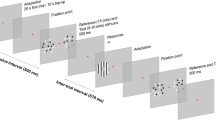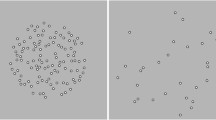Abstract
When observing a simple visual scene such as an array of dots, observers can easily and automatically extract their number. How does our visual system accomplish this? We investigate the role of specific spatial frequencies to the encoding of number through cross-adaptation. In two experiments, observers were peripherally adapted to six randomly generated sinusoidal gratings varying from relatively low-spatial frequency (M = 0.44 c/deg) to relatively high-spatial frequency (M = 5.88 c/deg). Subsequently, observers judged which side of the screen had a higher number of dots. We found a strong number-adaptation effect to low-spatial frequency gratings (i.e., participants significantly underestimated the number of dots on the adapted side) but a significantly reduced adaptation effect for high-spatial frequency gratings. Various control conditions demonstrate that these effects are not due to a generic response bias for the adapted side, nor moderated by dot size or spacing effects. In a third experiment, we observed no cross-adaptation for centrally presented gratings. Our results show that observers’ peripheral number perception can be adapted even with stimuli lacking any numeric or segmented object information and that low spatial frequencies adapt peripheral number perception more than high ones. Together, our results are consistent with recent number perception models that suggest a key role for spatial frequency in the extraction of number from the visual signal (e.g., Paul, Ackooij, Ten Cate, & Harvey, 2022), but additionally suggest that some spatial frequencies – especially in the low range and in the periphery – may be weighted more by the visual system when estimating number. We argue that the cross-adaptation paradigm is also a useful methodology for discovering the primitives of visual number encoding.











Similar content being viewed by others
Notes
An anonymous reviewer notes that this finding is especially surprising given that the energy of the gratings is likely to be much higher than that of 160 dots. We leave this as a useful observation for future work.
References
Aagten-Murphy, D., & Burr, D. (2016). Adaptation to numerosity requires only brief exposures, and is determined by number of events, not exposure duration. Journal of Vision, 16(10), 22–22.
Anobile, G., Cicchini, G. M., & Burr, D. C. (2016). Number As a Primary Perceptual Attribute: A Review. Perception, 45(1–2), 5–31. https://doi.org/10.1177/0301006615602599
Arrighi, R., Togoli, I., & Burr, D. C. (2014). A generalized sense of number. Proceedings of the Royal Society B: Biological Sciences, 281(1797), 20141791. https://doi.org/10.1098/rspb.2014.1791
Bueti, D., & Walsh, V. (2009). The parietal cortex and the representation of time, space, number and other magnitudes. Philosophical Transactions of the Royal Society B: Biological Sciences, 364(1525), 1831–1840. https://doi.org/10.1098/rstb.2009.0028
Burr, D., & Ross, J. (2008). A Visual Sense of Number. Current Biology, 18(6), 425–428. https://doi.org/10.1016/j.cub.2008.02.052
Castaldi, E., Aagten-Murphy, D., Tosetti, M., Burr, D., & Morrone, M. C. (2016). Effects of adaptation on numerosity decoding in the human brain. NeuroImage, 143, 364–377. https://doi.org/10.1016/j.neuroimage.2016.09.020
Castaldi, E., Piazza, M., Dehaene, S., Vignaud, A., & Eger, E. (2019). Attentional amplification of neural codes for number independent of other quantities along the dorsal visual stream. eLife, 8, e45160. https://doi.org/10.7554/eLife.45160
Dakin, S. C., Tibber, M. S., Greenwood, J. A., Kingdom, F. A. A., & Morgan, M. J. (2011). A common visual metric for approximate number and density. Proceedings of the National Academy of Sciences, 108(49), 19552–19557. https://doi.org/10.1073/pnas.1113195108
Dehaene, S. (2009). Origins of Mathematical Intuitions: The Case of Arithmetic. Annals of the New York Academy of Sciences, 1156(1), 232–259. https://doi.org/10.1111/j.1749-6632.2009.04469.x
Dehaene, S., & Changeux, J.-P. (1993). Development of Elementary Numerical Abilities: A Neuronal Model. Journal of Cognitive Neuroscience, 5(4), 390–407. https://doi.org/10.1162/jocn.1993.5.4.390
DeWind, N. K. (2019). The number sense is an emergent property of a deep convolutional neural network trained for object recognition [Preprint]. Animal Behavior; Cognition. https://doi.org/10.1101/609347
DeWind, N. K., Adams, G. K., Platt, M. L., & Brannon, E. M. (2015). Modeling the approximate number system to quantify the contribution of visual stimulus features. Cognition, 142, 247–265. https://doi.org/10.1016/j.cognition.2015.05.016
DeWind, N. K., Park, J., Woldorff, M. G., & Brannon, E. M. (2019). Numerical encoding in early visual cortex. Cortex, 114, 76–89. https://doi.org/10.1016/j.cortex.2018.03.027
Durgin, F. H. (2008). Texture density adaptation and visual number revisited. Current Biology, 18(18), R855–R856. https://doi.org/10.1016/j.cub.2008.07.053
Durgin, F. H., & Huk, A. C. (1997). Texture density aftereffects in the perception of artificial and natural textures. Vision Research, 37(23), 3273–3282. https://doi.org/10.1016/S0042-6989(97)00126-0
Feigenson, L., Dehaene, S., & Spelke, E. (2004). Core systems of number. Trends in Cognitive Sciences, 8(7), 307–314. https://doi.org/10.1016/j.tics.2004.05.002
Fornaciai, M., Brannon, E. M., Woldorff, M. G., & Park, J. (2017). Numerosity processing in early visual cortex. NeuroImage, 157, 429–438. https://doi.org/10.1016/j.neuroimage.2017.05.069
Fornaciai, M., Cicchini, G. M., & Burr, D. C. (2016). Adaptation to number operates on perceived rather than physical numerosity. Cognition, 151, 63–67. https://doi.org/10.1016/j.cognition.2016.03.006
Fornaciai, M., & Park, J. (2018). Early Numerosity Encoding in Visual Cortex Is Not Sufficient for the Representation of Numerical Magnitude. Journal of Cognitive Neuroscience, 30(12), 1788–1802. https://doi.org/10.1162/jocn_a_01320
Franconeri, S. L., Bemis, D. K., & Alvarez, G. A. (2009). Number estimation relies on a set of segmented objects. Cognition, 113(1), 1–13. https://doi.org/10.1016/j.cognition.2009.07.002
Gao, Y., Webster, M. A., & Jiang, F. (2019). Dynamics of contrast adaptation in central and peripheral vision. Journal of Vision, 19(6), 23–23. https://doi.org/10.1167/19.6.23
Gebuis, T., & Reynvoet, B. (2011). Generating nonsymbolic number stimuli. Behavior Research Methods, 43(4), 981–986. https://doi.org/10.3758/s13428-011-0097-5
Grill-Spector, K., & Malach, R. (2004). The human visual cortex. Annual Review of Neuroscience, 27(1), 649–677. https://doi.org/10.1146/annurev.neuro.27.070203.144220
Halberda, J., Mazzocco, M. M. M., & Feigenson, L. (2008). Individual differences in non-verbal number acuity correlate with maths achievement. Nature, 455(7213), 665–668. https://doi.org/10.1038/nature07246
Hochstein, S., & Ahissar, M. (2002). View from the top: Hierarchies and reverse hierarchies in the visual system. Neuron, 36(5), 791–804. https://doi.org/10.1016/S0896-6273(02)01091-7
Izard, V., Sann, C., Spelke, E. S., & Streri, A. (2009). Newborn infants perceive abstract numbers. Proceedings of the National Academy of Sciences of the United States of America, 106(25), 10382–10385. https://doi.org/10.1073/pnas.0812142106
Morgan, M. J., Raphael, S., Tibber, M. S., & Dakin, S. C. (2014). A texture-processing model of the “visual sense of number.” Proceedings of the Royal Society B: Biological Sciences, 281(1790), 20141137. https://doi.org/10.1098/rspb.2014.1137
Nasr, K., Viswanathan, P., & Nieder, A. (2019). Number detectors spontaneously emerge in a deep neural network designed for visual object recognition. Science Advances, 5(5), eaav7903. https://doi.org/10.1126/sciadv.aav7903
Nieder, A. (2005). Counting on neurons: The neurobiology of numerical competence. Nature Reviews Neuroscience, 6(3), 177–190. https://doi.org/10.1038/nrn1626
Nishida, S., Ledgeway, T., & Edwards, M. (1997). Dual multiple-scale processing for motion in the human visual System. Vision Research, 37(19), 2685–2698. https://doi.org/10.1016/S0042-6989(97)00092-8
Odic, D., & Starr, A. (2018). An Introduction to the Approximate Number System. Child Development Perspectives, 12(4), 223–229. https://doi.org/10.1111/cdep.12288
Park, J., DeWind, N. K., Woldorff, M. G., & Brannon, E. M. (2015). Rapid and Direct Encoding of Numerosity in the Visual Stream. Cerebral Cortex, bhv017. https://doi.org/10.1093/cercor/bhv017
Paul, J. M., van Ackooij, M., Ten Cate, T. C., & Harvey, B. M. (2022). Numerosity tuning in human association cortices and local image contrast representations in early visual cortex. Nature Communications, 13(1), 1–15.
Peirce, J., Gray, J. R., Simpson, S., MacAskill, M., Höchenberger, R., Sogo, H., & Lindeløv, J. K. (2019). PsychoPy2: Experiments in behavior made easy. Behavior Research Methods, 51(1), 195–203. https://doi.org/10.3758/s13428-018-01193-y
Pylyshyn, Z. W. (2001). Visual indexes, preconceptual objects, and situated vision. Cognition, 80(1–2), 127–158. https://doi.org/10.1016/S0010-0277(00)00156-6
Ross, J., & Burr, D. (2012). Number, texture and crowding. Trends in Cognitive Sciences, 16(4), 196–197. https://doi.org/10.1016/j.tics.2012.01.010
Smith, D. V., & McBurney, D. H. (1969). Gustatory cross-adaptation: Does a single mechanism code the salty taste? Journal of Experimental Psychology, 80(1), 101–105. https://doi.org/10.1037/h0027112
Sorensen, T., & Vasishth, S. (2016). Bayesian linear mixed models using Stan: A tutorial for psychologists, linguists, and cognitive scientists. The Quantitative Methods for Psychology, 12(3), 175–200. https://doi.org/10.20982/tqmp.12.3.p175
Stan Development Team. (2018). RStan: The R interface to Stan. Retrieved from http://mc-stan.org/
Stoianov, I., & Zorzi, M. (2012). Emergence of a ‘visual number sense’ in hierarchical generative models. Nature Neuroscience, 15(2), 194–196. https://doi.org/10.1038/nn.2996
Testolin, A., Zou, W.Y., & McClelland, J.L. (2020). Numerosity discrimination in deep neural networks: Initial competence, developmental refinement and experience statistics. Developmental Science, 23(5). https://doi.org/10.1111/desc.12940
Tsouli, A., Cai, Y., van Ackooij, M., Hofstetter, S., Harvey, B. M., te Pas, S.F., Dumoulin, S.O. (2021). Adaptation to visual numerosity changes neural numerosity selectivity. NeuroImage, 229, 117794. https://doi.org/10.1016/j.neuroimage.2021.117794
Tsouli, A., Dumoulin, S. O., te Pas, S. F., & van der Smagt, M. J. (2019). Adaptation reveals unbalanced interaction between numerosity and time. Cortex, 114, 5–16. https://doi.org/10.1016/j.cortex.2018.02.013
Vallortigara, G. (2017). An animal’s sense of number. In The Nature and Development of Mathematics: Cross Disciplinary Perspectives on Cognition, Learning and Culture (pp. 43–60). Routledge. Retrieved from https://www.routledge.com/The-Nature-and-Development-of-Mathematics-Cross-Disciplinary-Perspectives/Adams-Barmby-Mesoudi/p/book/9781315648163
Watt, R. J. (1991). Understanding vision. Academic Press.
Wei, X.-X., & Stocker, A. A. (2015). A Bayesian observer model constrained by efficient coding can explain ‘anti-Bayesian’ percepts. Nature Neuroscience, 18(10), 1509–1517. https://doi.org/10.1038/nn.4105
Wickham, H., Averick, M., Bryan, J., Chang, W., McGowan, L. D., François, R., ... Yutani, H. (2019). Welcome to the tidyverse. Journal of Open Source Software, 4(43), 1686. https://doi.org/10.21105/joss.01686
Acknowledgements
This research was supported by an NSERC Discovery Grant to D.O. The authors thank Manish Toofany and Nathan Louie for subject recruitment and data collection. The results of Experiment 1 were presented at the Vision Sciences Society meeting of 2019.
Author information
Authors and Affiliations
Corresponding author
Additional information
Publisher's Note
Springer Nature remains neutral with regard to jurisdictional claims in published maps and institutional affiliations.
Rights and permissions
Springer Nature or its licensor (e.g. a society or other partner) holds exclusive rights to this article under a publishing agreement with the author(s) or other rightsholder(s); author self-archiving of the accepted manuscript version of this article is solely governed by the terms of such publishing agreement and applicable law.
About this article
Cite this article
Bonn, C.D., Odic, D. Effects of spatial frequency cross-adaptation on the visual number sense. Atten Percept Psychophys 86, 248–262 (2024). https://doi.org/10.3758/s13414-023-02798-y
Accepted:
Published:
Issue Date:
DOI: https://doi.org/10.3758/s13414-023-02798-y




